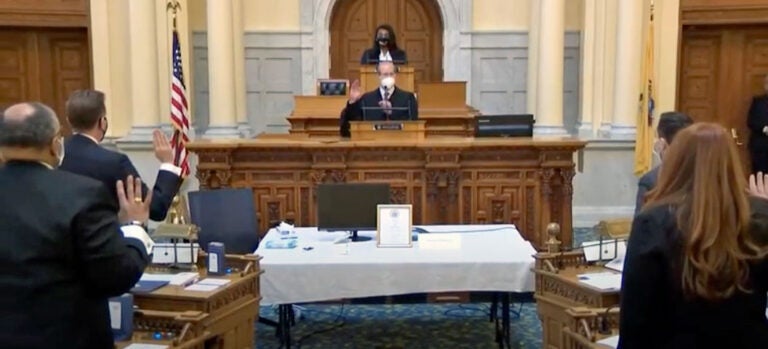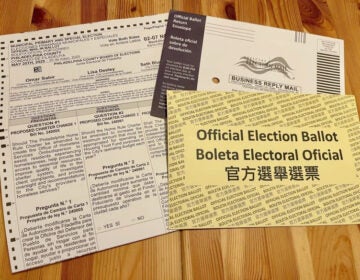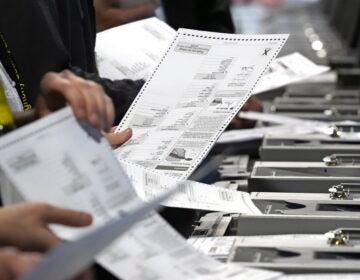Problems with signatures, envelopes top reasons NJ ballots rejected
Activists are planning a push to improve laws regarding the "cure" process for ballot challenges.

Stuart Jeff Rabner, Chief Justice of the New Jersey Supreme Court, swears in electors of state Electoral College.
This story originally appeared on NJ Spotlight.
___
A third of the mail-in ballots rejected in last month’s general election in New Jersey were disqualified due to signature mismatches. Another 40% did not count because of problems related to the ballot envelope certificate, according to a NJ Spotlight News analysis of the state’s vote-by-mail database.
Overall, about 66,500 ballots were rejected, or 1.4% of those cast in November.
The results of the election were certified last week by the state Board of Canvassers. Acting on those results Monday, the 14 New Jersey members of the Electoral College cast all of their votes for President-elect Joe Biden and Vice President-elect Kamala Harris. The state’s contingent met in the Assembly chambers in the State House in Trenton and conducted their business in less than 20 minutes in a meeting presided over by Tammy Murphy, the governor’s wife and one of the electors.
Typically a low-key meeting that occurs without much public interest, this year’s Electoral College vote was on full display in states across the nation — New Jersey’s was livestreamed by NJ Spotlight News —because President Donald Trump continues to try to overturn the results of an election he has called “rigged” without providing any proof. John Currie, chairman of the New Jersey Democratic State Committee, opened the proceedings by rejecting Trump’s claims and calling out Republicans in the state who have refused to acknowledge Biden’s win with 306 Electoral College votes.
‘Free and fair’
“I am proud to say the election was both free and fair here in New Jersey,” Currie said. “Despite the fact that President-elect Biden won … many in the Republican Party have refused to acknowledge the results of the election. They are in court attempting to disenfranchise tens of millions of voters and overturn the results of our democratic election. These actions, and the refusal of the Republicans in our state to denounce a threat of our democracy must be completely rejected. A peaceful transition of power is imperative to a functioning democracy. Together we must stand against any attempt to delegitimize and overturn a free and fair election.”
A record number of New Jersey voters — 4.64 million — cast ballots in this year’s unprecedented, virtually all-paper election, the state Division of Elections reported last week. And of those 66,500 ballots that were rejected, the NJ Spotlight News vote-by-mail database analysis found more than 50,500 of the discounted votes had been made using mail-in ballots. More than 300,000 people voted by provisional paper ballots, but there is no way to track the rejections of those from the state database.
Of the rejected mail-in ballots, a full third, or more than 16,800, were not counted because the signature on the certificate that accompanied the ballot did not match the one on file. Among the most common reasons election officials give for signature mismatches are that a person’s signature changes over time, young voters who did not learn cursive writing do not have a single signature and that the signatures of those who registered through motor vehicle agencies and signed an electronic pad often don’t match a person’s signature on paper.
Certifying certificates
The second and third most common reasons for ballot rejections were that the voter did not include the certificate with the ballot — because the certificate is perforated, people mistakenly detach it from the envelope — and that voters did not sign the certificate, responsible for 23.3% and 17.6% of rejections, respectively.
The ranking of these reasons differs sharply from primary ballot rejections; a ballot received after the deadline was the most common reason for it not counting, or 27.5% of all rejections. This time around, only 4% of all ballots were rejected because they arrived too late. Counties still counted ballots arriving up to a week after Election Day, provided they were postmarked by Nov. 3 and nearly 216,000 arrived during that period, the database shows.
Three key changes implemented by Gov. Phil Murphy in the law he signed laying out the rules for this primarily mail-in ballot election likely made the difference: The state increased the number of secure ballot drop boxes in each county to 10 or more; voters were able to drop off their ballots at in-person polling locations; and ballots without a postmark could be accepted up to 48 hours after polls closed.
The ballot rejection rate was lower than in the primary — when 2.7% were not counted. Still, the number of votes rejected was higher than in past elections because the turnout was so much higher.
Reducing ballot rejections
Voting advocates say the state still has more work to reduce the number of ballot rejections, which disenfranchise voters when the votes were cast legitimately save for a voter error or changed signature.
“I think that we will see the number of rejected ballots decrease in future elections as people become more accustomed to mail-in ballots and become more aware of ballot curing,” said Jesse Burns, executive director of the League of Women Voters of New Jersey.
Codified in law beginning with the general election, the process requires county election officials who might disqualify a ballot because of a signature mismatch to first send a letter or otherwise alert the voter and allow for the chance to certify that it was a proper vote. The state has not provided any information on the ballot-curing process, including how many cure letters were sent and how many ballots were saved because of voter certifications.
“We can make improvements to decrease rejections, including making mail-in ballot instructions and envelopes uniform across the state so statewide voter education efforts can be more effective, examining counties with particularly high rejection rates to determine why and come up with recommendations for improvement, and stepping up education efforts about the ballot-cure process,” she added.
Uyen “Winn” Khuong, founder and executive director of Action Together New Jersey and the Vote by Mail NJ website, said she is working on legislation to improve the state’s processes, which have flaws that the general election made clear.
For instance, the Ballot Cure Act enacted in late August specifies that a voter who has failed to sign the ballot certificate should be sent a cure letter, but that did not always happen, Khuong said. She blamed that on “a lack of guidance” from the secretary of state’s office to the counties. Close to 9,000 ballots were rejected because a certificate was not signed.
Additionally, the law required the state to set up a ballot tracker to allow voters to see whether a submitted ballot was accepted or rejected. But it did not specify when that status needed to be updated and the state database did not show a mail-in ballot’s status, other than that it had been received, until after counties had certified their election results on Nov. 20. By then, it was too late for a voter to cure a ballot problem.
Curing Ballot Cure Act
“I’m actually going to be very specific, because the first time I wrote it, it was very broad,” Khuong said of amending the Ballot Cure Act. “They waited until after the election to show that is was accepted, which really nullifies the whole purpose and intent of that part of it.”
A spokeswoman for the state Division of Elections had said the design of the database made it difficult for counties to update ballot acceptances in real-time.
Khuong said the database needs to be updated within 48 hours of a ballot’s acceptance or potential rejection. Some counties still have not updated the ballot tracker, now six weeks after the election and nearly a month after all but two counties certified their results.
“I want to talk to county elections officials to say, ‘Tell me your process, why was this not updated?’” Khuong said.
She said she hopes to see the law improved, and more public education of voters about mail-in balloting, next year. Murphy is up for reelection, along with the entire Legislature, and it is unclear how many voters will cast their ballots by mail, given more people are embracing vote-by-mail and a still-raging COVID-19 pandemic could prompt Murphy or lawmakers to again rely on mail-in balloting.
“There’s a lot of work to do,” she said. “I’m very disappointed in how it was unevenly executed.”
WHYY is your source for fact-based, in-depth journalism and information. As a nonprofit organization, we rely on financial support from readers like you. Please give today.






